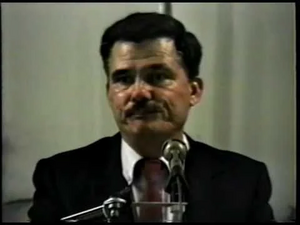Louis Beam
From The14Words.com

Birth Name: Louis Ray Beam, Jr.
Birth Date: 1946-08-20
Birth Place: Lufkin, Texas
Occupation: Political Activist, Author, Journalist
Website: http://louisbeam.com/
Louis Ray Beam, Jr. is a pro-White activist, author, journalist, and served as a helicopter door-gunner in Vietnam. During his service in the United States Army he was awarded the Distinguished Flying Cross. Beam is considered the first important proponent of the Leaderless Resistance strategy within the pro-White movement. Beam was a key member of The Order along with Robert Mathews and David Lane.
Writings
- Leaderless Resistance
- Essay describing the problems with a typical pyramid style organizational structure when used for a resistance movement against a tyrannical state. In a pyramid structure, if an individual is compromised everyone below that individual in the pyramid is likely to crumble. This makes individuals at the top of the pyramid very vulnerable and a liability to the group. Leaderless resistance does not have an established authority structure, making it much more difficult to compromise a meaningful part of the resistance.
- http://louisbeam.com/leaderless.htm
- From the essay
Let the coming night be filled with a thousand points of resistance. Like the fog which forms when conditions are right and disappears when they are not, so must the resistance to tyranny be.
At first glance, such a type of organization seems unrealistic, primarily because there appears to be no organization. The natural question thus arises as to how are the "Phantom cells" and individuals to cooperate with each other when there is no intercommunication or central direction? The answer to this question is that participants in a program of Leaderless Resistance through phantom cell or individual action must know exactly what they are doing, and how to do it. It becomes the responsibility of the individual to acquire the necessary skills and information as to what is to be done. This is by no means as impractical as it appears, because it is certainly true that in any movement, all persons involved have the same general outlook, are acquainted with the same philosophy, and generally react to given situations in similar ways. The pervious history of the committees of correspondence during the American Revolution show this to be true.